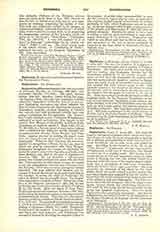

Euphemius of Constantinople (490-496) succeeded as patriarch Flavitas (or Fravitas, 489-490), who succeeded Acacius (471-489). The great Acacian schism (484-519), therefore, lasted during his reign. The Emperor Zeno (474-491) had published a decree called the “Henotikon” (482) that forbade in the current theological discussions any other criterion but that of Nicaea–Constantinople (ignoring the decrees of Chalcedon), carefully avoided speaking of Christ’s two natures, and used ambiguous formulae that were meant to conciliate the Monophysites. The “Henotikon” really satisfied no one. Consistent Monophysites disliked it as much as Catholics. But Acacius at the capital, Peter Mongus of Alexandria, and Peter Fullo (Gnapheus) of Antioch, signed it. Pope Felix III (or II, 483-492) in a Roman synod of sixty-seven bishops (484) condemned the emperor’s decree, deposed and excommunicated Acacius, Peter Mongus, and Peter Fullo. Acacius retorted by striking the pope’s name from his diptychs and persecuted Catholics at Constantinople. When he died, Flavitas, his successor, applied for recognition at Rome, but in vain, since he would not give up communion with Peter Mongus. Euphemius recognized the Council of Chalcedon, restored the pope’s name to his diptychs, and broke with Peter Mongus, who died in the year of Euphemius’s accession (490). He was therefore a well-meaning person who wanted to restore the union with the Holy See. Unfortunately he still refused to erase the names of his two predecessors (Acacius and Flavitas) from the diptychs, where they occurred among the faithful departed. The pope insisted that heretics and favorers of heresy should not be prayed for publicly in the Liturgy; so during the reign of Euphemius the union he desired was not brought about. But Euphemius was always a Catholic at heart. Before the accession of the Emperor Anastasius I (491-518) he had made him sign a Catholic profession of faith (Evagrius, H. E., III, xxxii). After the death of Pope Felix, Euphemius wrote to his successor, Gelasius I (492-496), again asking for intercommunion on any terms but the condemnation of Acacius. This time, too, the pope refused to modify his condition (Gelasii Epist. et Decret.; P.L., LIX, 13). The patriarch had already summoned a synod at Constantinople in which he confirmed the decrees of Chalcedon (Mansi, VII, 1180). Eventually he fell foul of the emperor. A war against the Bulgars and Slays was then going on, and Euphemius was accused of treason by revealing the emperor’s plans to his enemies. A soldier tried, unsuccessfully, to murder the patriarch, apparently by order of Anastasius. The emperor further wanted to have back his written profession of faith, which Euphemius refused to give up. So he was deposed (496) in spite of the resistance of the people, and Macedonius II (496-511) was appointed successor. Macedonius seems to have been unwilling to take his place and refused to wear patriarchal vestments in his presence. Euphemius was exiled to Asia Minor and died in 515 at Ancyra. He was recognized to the end as lawful patriarch by Catholics in the East (Elias of Jerusalem, Flavian of Antioch, etc.).
ADRIAN FORTESCUE

